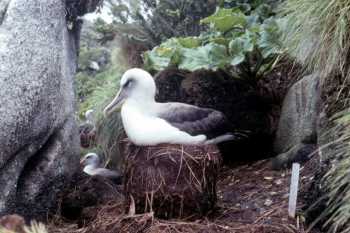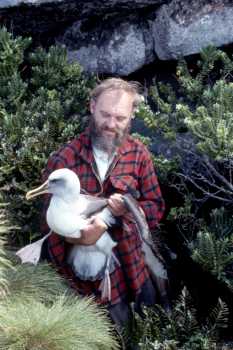Recent news items posted to this web site have reported on banded albatrosses that have lived for many decades, with two individuals reaching more than 60 years of age (click here).
New Zealand albatross pioneer Lancelot Richdale (click here for a review of his biography) visited The Snares Islands to work with Buller’s Albatrosses Thalassarche bulleri in early 1948, when he then banded 161 breeding birds. One of the birds he banded as a breeding female (G98) was rebanded as M-14721 in 1969 and was last recorded incubating in the same colony in March 1992 and again in March 1993 by Paul Sagar of the National Institute of Water & Atmospheric Research.

57 years. This old Buller’s Albatross on the nest was originally banded as G98 by Lance Richdale in February 1948 and was last recaptured and photographed on the same nest site in March 1993
Photograph by Paul Sagar
According to Paul “[w]ith a median age of 1st breeding of 12 years this bird was likely to be at least 57 years old when last seen.” The bird was photographed in 1948 by Lance Richdale and again in 1993 by Paul Sagar. These two photographs may be compared on page 128 of Neville Peat’s biography of Richdale. No signs of aging discernible!

This Buller’s Albatross held by Don Horning in January 1977 was originally banded as G63 by Lance Richdale in February 1948; it was last recaptured in February 1983
Photograph courtesy of Paul Sagar
Selected References:
Peat, N. 2011. Seabird Genius. The Story of L.E. Richdale, the Royal Albatross, and the Yellow-eyed Penguin. Dunedin: Otago University Press. 288 pp.
Richdale, L.E. 1949. The pre-egg stage in Buller’s Mollymawk. Biological Monographs No. 2. 50 pp.
Richdale, L.E. 1950. The pre-egg stage in the albatross family. Biological Monographs No.3. 92 pp.
Richdale, L.E. 1949. Buller's Mollymawk: incubation data. Bird-Banding 20: 127-141.
Richdale, L.E. & Warham, J. 1973. Survival, pair bond and nest-site tenacity in Buller's Mollymawk. Ibis 115: 257-263.
Sagar, P.M. & Warham, J. 1993. A long-lived Southern Buller’s Mollymawk (Diomedea bulleri bulleri) with a small egg. Notornis 40: 303-304.
With thanks to Paul Sagar, National Institute of Water & Atmospheric Research Ltd, New Zealand for information and photographs.
John Cooper, ACAP Information Officer, 25 February 2013

 English
English  Français
Français  Español
Español